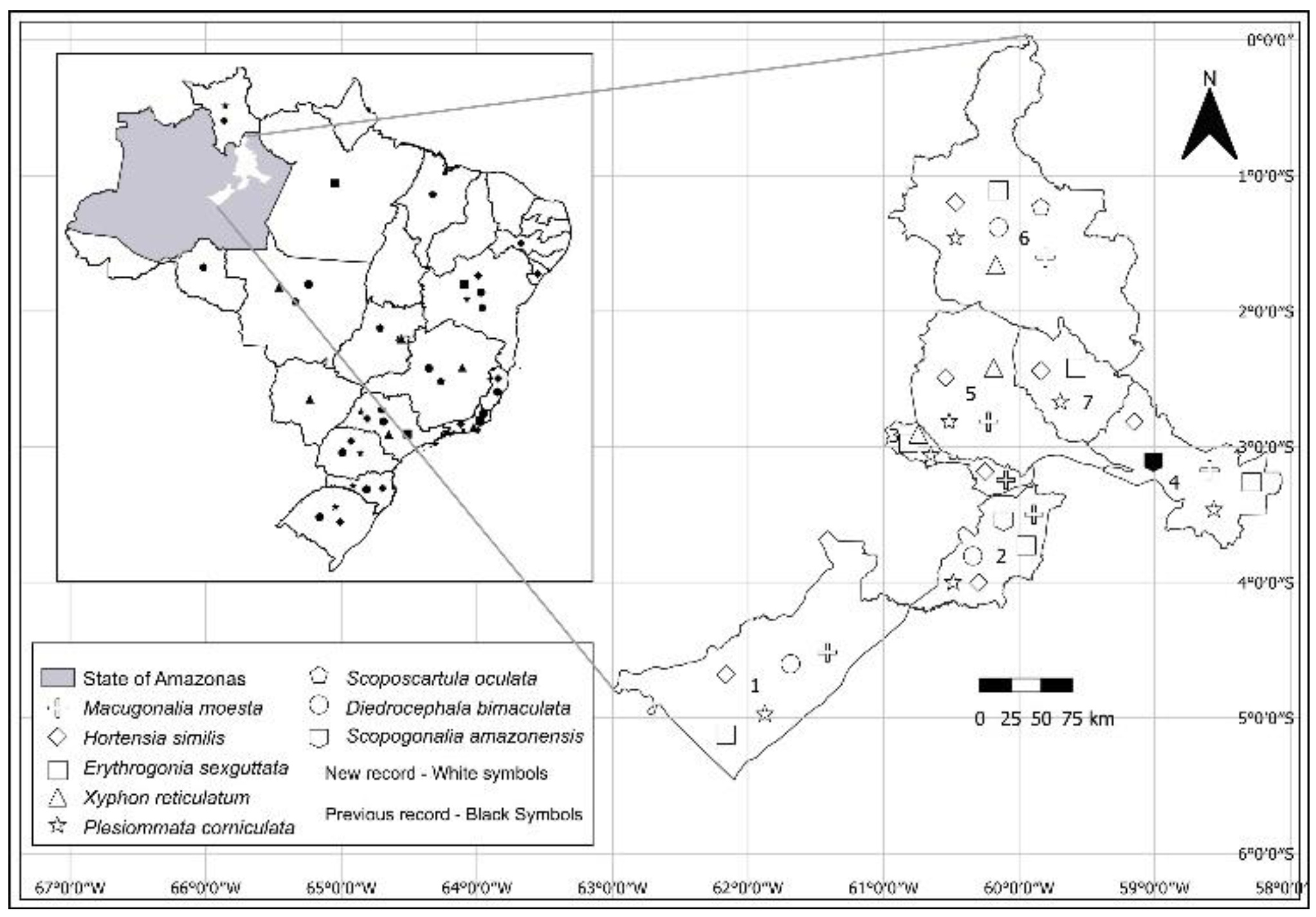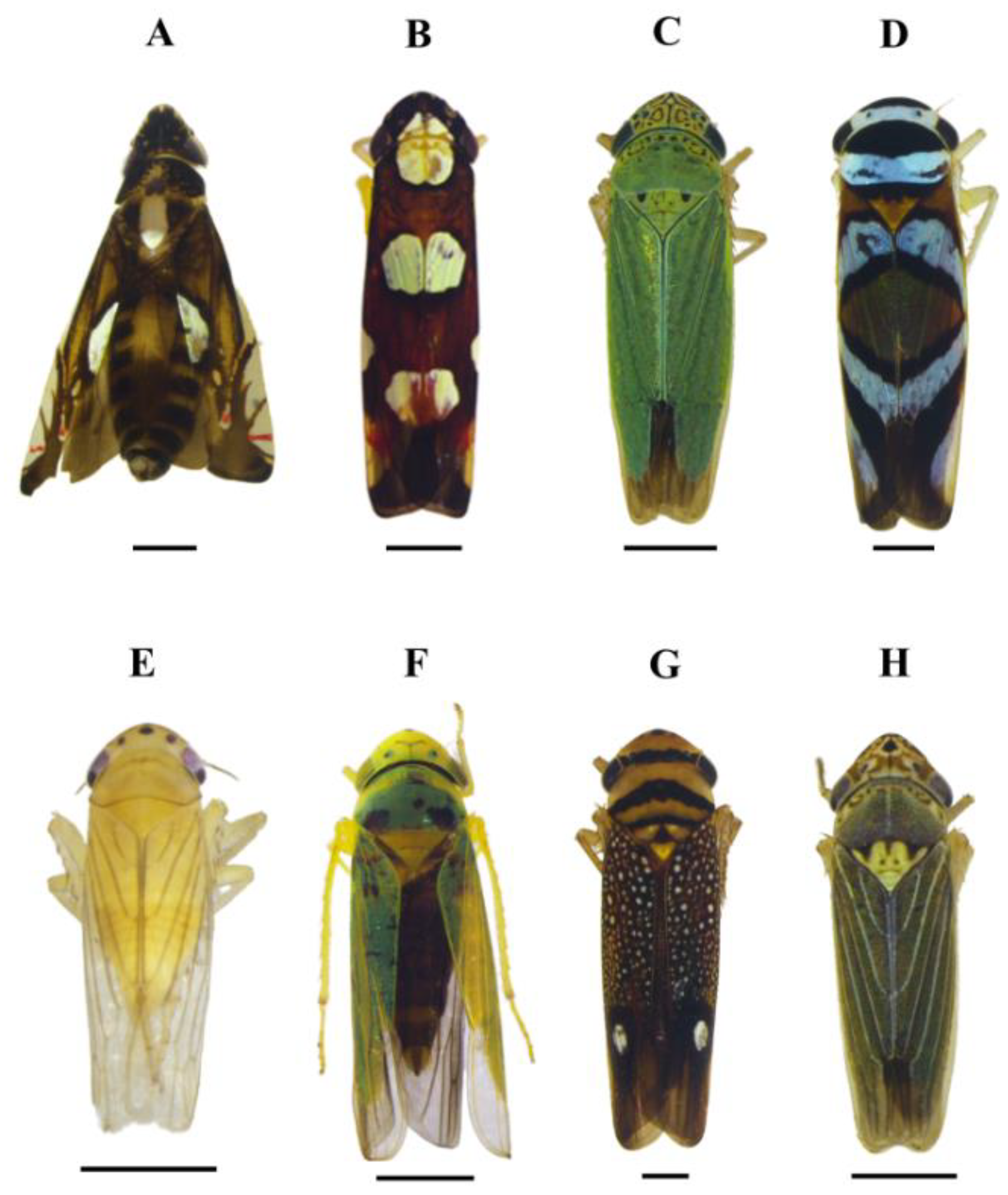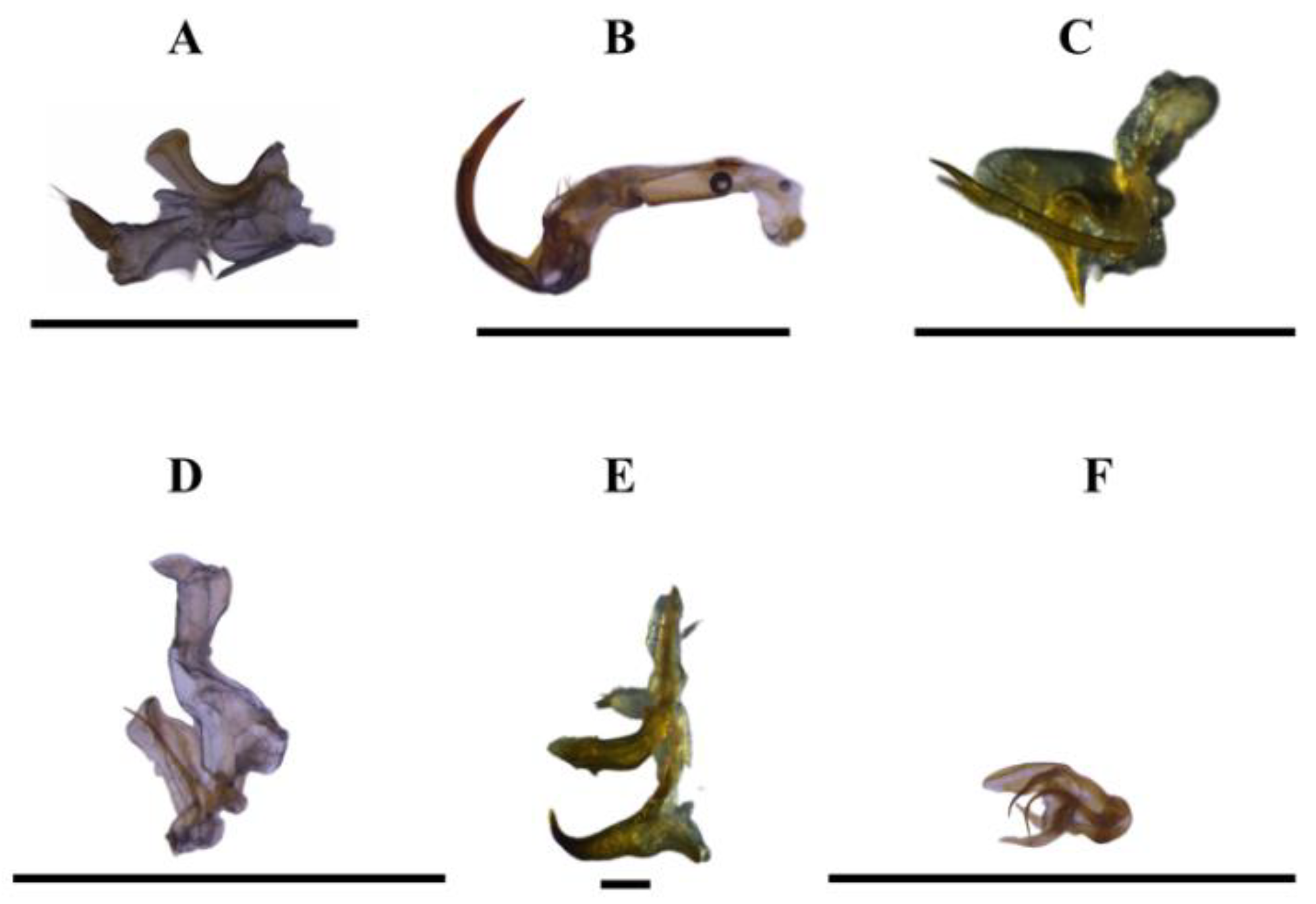Submitted:
29 May 2024
Posted:
30 May 2024
You are already at the latest version
Abstract

Keywords:
Introduction
Methods
Results
Diedrocephala bimaculata (Gmelin, 1789)
Erythrogonia sexguttata (Fabricius, 1803)
Hortensia similis (Walker, 1851)
Macugonalia moesta (Fabricius, 1803)
Plesiommata corniculata Young, 1977
Scopogonalia amazonensis Leal & Creão-Duarte, 2016
Scoposcartula oculata (Signoret, 1853)
Xyphon reticulatum (Signoret, 1854)



Discussion
Author Contributions
Funding
Acknowledgments
Data Availability
Conflicts of Interest
References
- Antunes, C.; Buys, S.; Felix, M. Inventário preliminar das cigarrinhas da tribo Cicadellini (Insecta: Hemiptera: Cicadellidae) ocorrentes no Estado do Espírito Santo, Brasil, com ênfase no município de Santa Teresa. Boletim do Museu de Biologia Mello Leitão 2015, 37, 9–25. [Google Scholar]
- Araújo, E.V.B. Detecção de Xylella fastidiosa e quantificação da clorose variegada dos citros em pomares no Amazonas. Master´s thesis, Universidade Federal do Amazonas, Manaus, Brazil, 2023; 86p. [Google Scholar]
- Azevedo-Filho, W.S.; Carvalho, G.S. Cigarrinhas de citros no Rio Grande do Sul: taxonomia; Edipucrs: Porto Alegre, Brazil, 2006; 141p. [Google Scholar]
- Azevedo-Filho, W.S.; Paladini, A.; Botton, M.; Carvalho, G.S.; Ringenberg, R.; Lopes, J.R.S. Manual de identificação de cigarrinhas em videira, 1st edition; Embrapa: Brasília DF, Brazil, 2011; 95p. [Google Scholar]
- Azevedo-Filho, W.S.; Tolotti, A.; Carvalho, G.S.; Müller, C.; Botton, M.; Lopes, J.R.S. Guia Ilustrado: cigarrinhas na cultura da ameixeira; Useb: Pelotas, Brazil, 2016; 135p. [Google Scholar]
- Bartlett, C.R.; Deitz, L.L.; Dmitriev, D.A.; Sanborn, A.F.; Soulier-Perkins, A.; Wallace, M.S. The diversity of the true hoppers (Hemiptera: Auchenorrhyncha). In Insect biodiversity: science and society, 1st edition; Foottit, R.G., Adler, P.H., Eds.; John Wiley & Sons: New York, USA, 2018; pp. 501–590. [Google Scholar] [CrossRef]
- Carvalho, R.A.; Mejdalani, G.L. Remarkable morphological features of taxonomic interest in the female genitalia of five Erythrogonia species (Hemiptera: Cicadomorpha: Cicadellidae). Zootaxa 2014, 3872, 275–290. [Google Scholar] [CrossRef]
- Carvalho, I.G.B.; Esteves, M.B.; Froza, J.A.; Kleina, H.T.; Souza-Neto, R.R.; Souza, A.A.; Coletta-Filho, H.D. Doenças associadas à Xylella fastidiosa no Brasil. Revisão anual de patologia de plantas 2022, 28, 50–68. [Google Scholar] [CrossRef]
- Catanach, T.A.; Dietrich, C.H.; Woolley, J.B. A revision of the New World sharpshooter genus Xyphon Hamilton (Hemiptera: Cicadellidae: Cicadellinae). Zootaxa 2013, 3741, 490–510. [Google Scholar] [CrossRef]
- Cavichioli, R.R.; Zanol, K.M. Espécies de Cicadellinae, Deltocephalinae (Homoptera, Cicadellidae) da Ilha de Maracá, Roraima. Acta Amazonica 1991, 21, 55–61. [Google Scholar] [CrossRef]
- Coelho, J.H.; Ximenes, N.L.; Felippe, M.R.; Montesino, L.H.; Garbim, L.F.; Sanches, A.L.; Pria, W.D., Jr.; Yamamoto, P.T. Análise faunística de cigarrinhas (Hemiptera: Auchenorrhyncha, Cicadellidae) em um pomar de laranjeira 'Westin'. Neotropical Entomology 2008, 37, 449–456. [Google Scholar] [CrossRef]
- Cornara, D.; Morente, M.; Markheiser, A.; Bodino, N.; Tsai, C.W.; Fereres, A.; Redak, R.A.; Perring, T.M.; Lopes, J.R.S. An overview on the worldwide vectors of Xylella fastidiosa. Entomologia Generalis 2019, 39, 157–181. [Google Scholar] [CrossRef]
- Defea, B.; Virla, E.G.; Logarzo, G.A.; Cavichioli, R.R.; Tapia, S.; Aguirre, M.R.; Kay, F.M.C.; Martin, S.; Paradell, S.L. Contributions to the knowledge of the Cicadellini sharpshooters (Hemiptera: Cicadellidae) associated with citrus orchards in Argentina. Zootaxa 2022, 5205, 55–72. [Google Scholar] [CrossRef]
- Faprin, P.E.; Azevedo-Filho, W.S.; Pauletti, G.F. Análise faunística e flutuação populacional de cigarrinhas (Cicadellidae: Cicadellinae) potenciais vetoras de Xylella fastidiosa associadas à cultura de citro no Vale do Caí, RS. Caderno de pesquisa: série biologia 2014, 26, 54–64. [Google Scholar]
- Feitosa, M.C. Comunidade e dinâmica populacional de cigarrinhas (Hemiptera: Cicadellidae: Cicadellinae) seus parasitoides de ovos (Hymenoptera: Chalcidoidea) em pomares cítricos no Amazonas, Brasil. PhD thesis, Instituto Nacional de Pesquisas da Amazônia, Manaus, Brazil, 2017; 120p. [Google Scholar]
- Franco, P.V.M. Cigarrinhas (Hemiptera: Cicadellidae: Cicadellinae): Análise da comunidade das espécies potencialmente transmissoras de Xylella fastidiosa Wells et al. em pomares de laranja (Citrus sinensis L.) no Amazonas. Master´s thesis, Universidade Federal do Amazonas, Manaus, Brazil, 2023; 80p. [Google Scholar]
- Froza, J.A. Levantamento de espécies de cigarrinhas (Hemiptera: Auchenorrhyncha) com ênfase em possíveis vetores de Xylella fastidiosa em pomares de oliveira na Serra da Mantiqueira. Master´s thesis, Universidade de São Paulo: Piracicaba, Brazil, 2017; 90p. [Google Scholar]
- Froza, J.A. Papel de espécies de cigarrinhas (Hemiptera: Auchenorrhyncha) na disseminação de Xylella fastidiosa em oliveira na Serra da Mantiqueira. PhD thesis, Universidade de São Paulo, Piracicaba, Brazil, 2022; 86p. [Google Scholar]
- Giacomelli, F.; Schneider, N.A.; Azevedo-Filho, W.S.; Arioli, C.J. Diversity, population fluctuation and faunistic analysis of sharpshooters (Hemiptera: Cicadellidae: Cicadellinae) in plum orchards in Videira, Santa Catarina, Brazil. International Journal of Pest Management 2022, 1–12. [Google Scholar] [CrossRef]
- Giustolin, T.A.; Lopes, J.R.; Querino, R.B.; Cavichioli, R.R.; Zanol, K.; Azevedo-Filho, W.S.; Mendes, M.A. Diversidade de Hemiptera Auchenorrhyncha em citros, café e fragmento de floresta nativa do Estado de São Paulo. Neotropical Entomology 2009, 38, 834–841. [Google Scholar] [CrossRef]
- Graner, L.S. Cigarrinhas potenciais vetoras (Hemiptera: Cercopidae e Cicadellidae) e plantas infestantes associadas à epidemiologia da Escaldadura das Folhas da Ameixeira. Master´s thesis, Universidade de São Paulo, Piracicaba, Brazil, 2014; 92p. [Google Scholar]
- Haddad, N.; Smaili, M.C.; Afechtal, M.; Cavalieri, V.; Benkirane, R.; El Handi, K.; Abou Kubba, R. Worldwide potential insect vectors of Xylella fastidiosa and assessment of their importance with a focus on Morocco. Hellenic Plant Protection Journal 2024, 17, 1–30. [Google Scholar] [CrossRef]
- Hickel, E.R.; Ducroquet, J.P.H.; Leite, J.R.R.P.; Leite, R.M. Fauna de Homoptera: Auchenorrhyncha em pomares de ameixeira em Santa Catarina. Neotropical Entomology 2001, 30, 725–729. [Google Scholar] [CrossRef]
- Hopkins, D.L. Xylella fastidiosa: xylem-limited bacterial pathogen of plants. Annual Review of Phytopathology 1989, 27, 271–290. [Google Scholar] [CrossRef]
- IBGE (Instituto Brasileiro de Geografia e Estatística) (2022) Produção de laranja, Amazonas, Brazil. Available online: https://www.ibge.gov.br/explica/producao-agropecuaria/laranja/am (accessed on 11 October 2023).
- IDAM (Instituto de Desenvolvimento Agropecuário do Estado do Amazonas) (2019) Relatório de atividades. Manaus, Brazil, 81pp. Available online: http://www.idam.am.gov.br/wp-content/uploads/2020/07/10-RAIDAM2019.pdf (accessed on 11 October 2023).
- IDAM (Instituto de Desenvolvimento Agropecuário do Estado do Amazonas) (2022) Relatório de atividades. Manaus, Brazil, 105pp. Available online: http://www.idam.am.gov.br/wp-content/uploads/2020/07/RAIDAM2022-Versao-Final.pdf (accessed on 11 October 2023).
- Leal, A.H.; Creão-Duarte, A.J.; Mejdalani, G. Taxonomic review of Scopogonalia Young, 1977 (Insecta: Hemiptera: Cicadellidae: Cicadellini) with description of six new species. Journal of Natural History 2016, 50, 1513–1542. [Google Scholar] [CrossRef]
- Leal, A.H.; Mejdalani, G.; Cavichioli, R.R.; Carvalho, R.A. Taxonomy and phylogeny of the leafhopper genus Scoposcartula (Insecta: Hemiptera: Cicadellidae). Sistematic and Biodiversity 2009, 7, 215–233. [Google Scholar] [CrossRef]
- Marucci, R.C. Espécies de cigarrinhas (Hemiptera: Cicadellidae: Cicadellinae) em pomares de citros da região de Bebedouro (SP). Master´s thesis, Universidade de São Paulo, Piracicaba, Brasil, 1998; 95p. [Google Scholar]
- Marucci, R.C.; Cavichioli, R.R.; Zucchi, R.A. Espécies de cigarrinhas (Hemiptera, Cicadellidae, Cicadellinae) em pomares de citros da região de Bebedouro, SP, com descrição de uma espécie nova de Acrogonia Stål. Revista Brasileira de Entomologia 2002, 46, 149–164. [Google Scholar] [CrossRef]
- Medler, J.T. A review of the genus Erythrogonia Melichar (Homoptera, Cicadellidae); Nelson, R.H., Knight, K.L., Bunn, R.W., Foote, R.H., Eds.; Miscellaneous Publications of the Entomological Society of America: Baltimore, USA, 1963; 33p. [Google Scholar] [CrossRef]
- Mejdalani, G. Morfologia externa dos Cicadellinae (Homoptera, Cicadellidae): comparação entre Versigonalia ruficauda (Walker)(Cicadellini) e Tretogonia cribrata Melichar (Proconiini), com notas sobre outras espécies e análise da terminologia. Revista Brasileira de Zoologia 1998, 15, 451–544. [Google Scholar] [CrossRef]
- Mejdalani, G.; Coelho, L.B.; Gonçalves, A.C.; Carvalho, R.A.; Rodrigues, L.G.; Costa, L.A.; Felix, M.; Silva, E.R. Espécies de cigarrinhas (Hemiptera: Membracoidea, Cicadellidae) registradas no Estado do Rio de Janeiro, Brasil. Arquivos do Museu Nacional 2009, 67, 155–171. [Google Scholar]
- Menegatti, A.C.O.; Garcia, F.R.M.; Savaris, M. Análise faunística e flutuação populacional de cigarrinhas (Hemiptera, Cicadellidae) em pomar cítrico no município de Chapecó, Santa Catarina. Biotemas 2008, 21, 53–58. [Google Scholar] [CrossRef]
- Miranda, M.P.; Lopes, J.R.; Nascimento, A.S.; Santos, J.L.; Cavichioli, R.R. Levantamento populacional de cigarrinhas (Hemiptera: Cicadellidae) associadas à transmissão de Xylella fastidiosa em pomares cítricos do Litoral Norte da Bahia. Neotropical Entomology 2009, 38, 827–833. [Google Scholar] [CrossRef] [PubMed]
- Miranda, M.P.; Nascimento, A.S.; Santos-Filho, H.P.; Barbosa, C.J.; Silva, L.M.S.; Matrangolo, W.J.R. Occurrence of sharpshooters in citrus orchards affected by CVC in north coast of Bahia and south of Sergipe state, Brazil. In International Congress of Entomology 21. Foz do Iguaçu, Brazil, 2000; 816pp.
- Molina, R.O.; Nunes, W.M.; Gonçalves, A.M.; Corazza-Nunes, M.J.; Zanutto, C.A. Ocorrência de cigarrinhas vetoras de Xylella fastidiosa em pomares cítricos do município de Loanda, no Noroeste do Paraná. Citrus Research & Technology 2006, 27, 243–250. [Google Scholar]
- Müller, C. Análise faunística e flutuação populacional de cigarrinhas (Hemiptera: Cicadellidae) potenciais vetoras de Xylella fastidiosa em pomares de ameixeira nos estados do Rio Grande do Sul e São Paulo. Master´s thesis, Universidade de São Paulo, Piracicaba, Brazil, 2008; 67p. [Google Scholar]
- Müller, C.; Esteves, M.B.; Kleina, H.T.; Nondillo, A.; Botton, M.; Lopes, J.R. First sharpshooter species proven as vectors of Xylella fastidiosa subsp. multiplex in Prunus salicina trees in Brazil. Tropical Plant Pathology 2021, 46, 386–391. [Google Scholar] [CrossRef]
- Nunes, W.; Molina, R.D.; Albuquerque, F.A.; Corazza-Nunes, M.J.; Zanutto, C.A.; Machado, M.A. Flutuação Populacional de cigarrinhas cetoras de Xylella fastidiosa Wells et al. em pomares comerciais de citros no Noroeste do Paraná. Neotropical Entomology 2007, 36, 254–260. [Google Scholar] [CrossRef] [PubMed]
- Ott, A.P.; Azevedo-Filho, W.S.; Ferrari, A.; Carvalho, G.S. Abundância e sazonalidade de cigarrinhas (Hemiptera, Cicadellidae, Cicadellinae) em vegetação herbácea de pomar de laranja doce, no município de Montenegro, Estado do Rio Grande do Sul, Brasil. Iheringia: Série Zoologia 2006, 96, 425–429. [Google Scholar] [CrossRef]
- Paris, P.; Tolotti, S.; Peruzzo, L.; Azevedo-Filho, W.S. Cigarrinhas (Cicadellidae: Cicadellinae) na cultura da canola no município de Vacaria, Rio Grande do Sul, Brasil. Caderno de Pesquisa 2013, 24, 14–22. [Google Scholar]
- Peruzo, L.; Paris, P.; Poletto, G.; Ferri, T.; Botton, M.; Azevedo-Filho, W.S. Análise faunística e flutuação populacional de cigarrinhas (Cicadellidae: Cicadellinae) potenciais vetoras de Xylella fastidiosa associadas à cultura da videira nos munícipios de Bento Gonçalves e Pinto Bandeira, RS. Caderno de Pesquisa 2014, 25, 27–39. [Google Scholar]
- Prando, J.S. Delimitação de espécies e filogeografia de cigarrinhas do gênero Hortensia Metcalf & Bruner, 1936 (Insecta: Hemiptera: Cicadellidae). Master´s thesis, Universidade Federal do Rio de Janeiro, Rio de Janeiro, Brazil, 2017; 75p. [Google Scholar]
- Redak, R.A.; Purcell, A.H.; Lopes, J.R.; Blua, M.J.; Mizell, R.F., III; Andersen, P.C. The biology of xylem fluid-feeding insect vectors of Xylella fastidiosa and their relation to disease epidemiology. Annual Review of Entomology 2004, 49, 243–270. [Google Scholar] [CrossRef]
- Resende, L.A. Ocorrência de Xylella fastidiosa e identificação de potenciais vetores em cultivos de oliveira no Espírito Santo. Master´s thesis, Universidade Federal de Viçosa, Viçosa, Brazil, 2020; 31p. [Google Scholar]
- Ringenberg, R.; Lopes, J.R.; Botton, M.; Azevedo-Filho, W.S.; Cavichioli, R.R. Análise faunística de cigarrinhas (Hemiptera: Cicadellidae) na cultura da videira no Rio Grande do Sul. Neotropical Entomology 2010, 39, 187–193. [Google Scholar] [CrossRef]
- Ringenberg, R.; Lopes, J.R.S.; Muller, C.; Azevedo-Filho, W.S.; Paranhos, B.A.J.; Botton, M. Survey of potential sharpshooter and spittlebug vectors of Xylella fastidiosa to grapevines at the São Francisco River Valley, Brazil. Revista Brasileira de Entomologia 2014, 58, 212–218. [Google Scholar] [CrossRef]
- Sakakibara, A.A.; Cavichioli, R.R. Duas espécies novas de Diedrocephala Spinola (Homoptera, Cicadellidae). Revista brasileira de Entomologia 1982, 26, 241–246. [Google Scholar]
- Santos-Filho, H.P.; Souza, T.; Ledo, C.D.; Carvalho, H.W. Influência de brotações novas sobre a atratividade de cigarrinhas e o aumento da incidência e da severidade da clorose variegada dos citros Boletim de Pesquisa e Desenvolvimento 88, Bahia, Brazil, 2017; 23pp.
- Schneider, N.A.; Azevedo-Filho, W.S.; Giacomelli, F. Population fluctuation and faunistic analysis of sharpshooters (Hemiptera: Cicadellidae: Cicadellinae) in plum orchards in the municipality of Protásio Alves, Rio Grande do Sul State, Brazil. Journal of the Kansas Entomological Society 2017, 90, 269–282. [Google Scholar] [CrossRef]
- Silva, E.R.; Coelho, L.B.; Cavalcante, S.S.; Campos, M.F.; Amarante, B.E. Entomologia urbana: registros novos e adicionais para os municípios do Rio de Janeiro e de Piraí, Brasil. Revista Científica Semana Acadêmica 2016, 1, 1–13. [Google Scholar]
- Vásquez, J.; Lozada, P. Las especies de cigarritas (Homiptera, Cicadellidae) associadas a las plantas medicinales y ornamentales en Allpahuayo, Iquitos-Perú. Folia Amazônica 2014, 23, 199–204. [Google Scholar] [CrossRef]
- Wilson, M.R.; Turner, J.A.; McKamey, S.H. Sharpshooter leafhoppers of the world (Hemiptera: Cicadellidae subfamily Cicadellinae); National Museum Wales: Wales, United Kingdom, 2009; Available online: http://naturalhistory.museumwales.ac.uk/Sharpshooters (accessed on 27 July 2023).
- Yamamoto, P.T. Cigarrinhas em citros no Estado de São Paulo. Laranja 1996, 17, 237–239. [Google Scholar]
- Yamamoto, P.T.; Gravena, S. Espécies e abundância de cigarrinhas e psilídeos (Homoptera) em pomares de citros. Anais da Sociedade Entomológica do Brasil 2000, 29, 169–176. [Google Scholar] [CrossRef]
- Yamamoto, P.T.; Roberto, S.R.; Júnior, P.; Dalla, W.; Felippe, M.R.; Freitas, E.P. Espécies e flutuação populacional de cigarrinhas em viveiro de citros, no município de Mogi-Guaçu-SP. Revista Brasileira de Fruticultura 2002, 24, 389–394. [Google Scholar] [CrossRef]
- Young, D.A. Taxonomic study of the Cicadellinae, part 1: Proconiini. Bulletin of the United States National Museum 1968, 261, 1–287. [Google Scholar] [CrossRef]
- Young, D.A. Taxonomic study of the Cicadellinae (Homoptera: Cicadellidae), part 2: New World Cicadellini and genus Cicadella. Technical bulletin of the North Carolina Agricultural Experiment Station 1977, 239, 1–1135. [Google Scholar]
Disclaimer/Publisher’s Note: The statements, opinions and data contained in all publications are solely those of the individual author(s) and contributor(s) and not of MDPI and/or the editor(s). MDPI and/or the editor(s) disclaim responsibility for any injury to people or property resulting from any ideas, methods, instructions or products referred to in the content. |
© 2024 by the authors. Licensee MDPI, Basel, Switzerland. This article is an open access article distributed under the terms and conditions of the Creative Commons Attribution (CC BY) license (http://creativecommons.org/licenses/by/4.0/).




